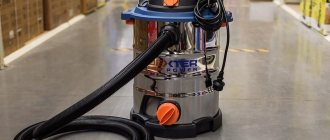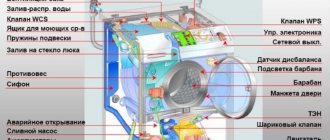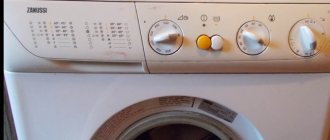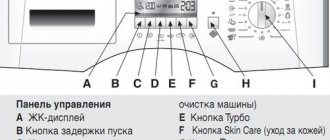Reasons for loud operation of a vacuum cleaner
There are several main reasons why the vacuum cleaner becomes loud.
An overfilled dust bin is one of the most common causes, especially for older models. The dust bag can hold a certain amount of debris and must be changed periodically for disposable dust bags or cleaned (for reusable cloth bags). An acceptable filling level is around 80% of the volume, then the filtering capacity of the bag decreases significantly, the suction power drops, and the engine begins to operate at maximum power. Modern models of vacuum cleaners have a special light indicator that signals when the dust container is full.
Advice:
You should not reuse a disposable bag - it has low strength and a short service life. It can rupture at any time and all debris and dust will fall into the engine compartment, which can cause serious damage. Reusable bags need to be washed to improve their airflow permeability.
Clogged filters – modern vacuum cleaners have a multi-stage air purification system; premium-segment vacuum cleaners with HEPA filters are capable of capturing up to 95–99% of contaminants. After prolonged use, the filters become clogged, so additional power is required to allow air to pass through them. Some filters (mostly foam rubber, coarse filters) can be washed and they will almost completely restore their filtering capabilities.
Foreign objects - the traction of the vacuum cleaner may weaken due to balls of dust, large pieces of paper or debris, toys and other objects getting into the hose that will interfere with the free passage of air flow.
Technical fault – loud engine operation may be caused by worn bearings. If the filtration system is not promptly and completely cleaned, dry dust enters the engine compartment, settling on moving parts. As a result, the coefficient of friction increases sharply; if the bearings are not lubricated in time, they begin to operate virtually “dry,” which leads to their wear. It is much worse if the problem is caused by a winding malfunction or component failure. In this case, you will have to contact the service center.
Important:
If, when turned on, the new vacuum cleaner immediately starts to work very loudly, you must immediately contact a service center. It is highly likely that the problem is related to a manufacturing defect, so this vacuum cleaner can be exchanged.
Correct operation
As practice shows, most breakdowns occur due to improper operation of an electrical appliance. To extend the life of your microwave, you should follow simple recommendations:
- Do not use metal containers to heat food.
- It is not allowed to operate the electrical appliance without food in the working chamber.
- Liquids and raw eggs should only be heated in closed containers.
- The working chamber should be kept clean
A microwave oven is a complex and dangerous household electrical appliance. Along with ease of use, it requires competent operation. The reasons for a microwave malfunction can be different and are not always determined by eye.
Repairing the device should be approached with care and caution. A microwave oven has the property of accumulating electricity, which can cause damage if repairs are not carried out correctly.
If there are some doubts, it is better to give preference to quality repairs at a service center.
Tags: , sconce, view, engine, house, , replacement, sign, like, , , power, opn, rule, wire, start, vacuum cleaner, , work, size, repair, recipe, row, garden, light, system, means , term, ten, type, current, , filter, shield, electricity
Why does the vacuum cleaner make a loud noise?
Photo 1. The vacuum cleaner needs diagnostics
Just yesterday the vacuum cleaner was working fine, but then a slight noise began to appear during its operation. After some time, it already hums loudly, sometimes “like an airplane,” quite irritating the auditory receptors. Moreover, at the same time, it begins to absorb dust worse and the room smells of burning. There is no point in taking risks when working with such a device! It's time to deal with it and eliminate the cause of the noise of your vacuum cleaner before the device's motor burns out.
Reasons for shutdown
The most common reason for a vacuum cleaner to turn off spontaneously during operation is overheating of its parts and components . This can be caused by various factors.
- Severe contamination of the inlet or outlet filter (they must be cleaned regularly).
- High temperature in the room where cleaning is carried out.
- Clogged flexible hose or inlet.
- Contamination of the motor or electronic board components.
- Worn motor brush assembly.
- Poor contact of one of the engine parts.
- Broken contact in the power outlet.
Typical Causes of Loud Noise
Does your vacuum cleaner vibrate and hum suspiciously loudly when running? There are several reasons for this problem:
- accumulation of large debris in the hose;
- compressor malfunctions;
- engine failure;
- clogging of the filtration system;
- malfunctions of electronic components;
- damage to bearings and commutators;
- brush abrasion;
- impeller imbalance.
Important! Sometimes, when there is excessive noise, the body of the device heats up, vibrates, and it periodically turns off.
Troubleshooting
In the vast majority of cases, the cause of the malfunction is the failure of the motor. This can happen with absolutely every model from any manufacturer. The main sign of its malfunction is excessive noise and the formation of a dust cloud. Also, engine failure directly affects the suction power of the device.
Weak or no suction power may also indicate a hose malfunction. Also, evidence of a violation of the hose tightness can be excessively quiet operation of the device.
A decrease in the suction speed of the product may indicate bearing failure. The main symptom of this malfunction is the periodic restoration of normal operation of the device.
Low suction speed may be due to bearing failure
The reason that the device does not turn on may be a simple broken cord. First, the cord stops winding up and coming out normally, and then it becomes impossible to fix and remove it, which eventually leads to its fracture.
The vacuum cleaner may be loud afterward. reasons:
- – Dust container overfilled.
- – Filters clogged.
- – Foreign objects.
- – Technical malfunction.
So my vacuum cleaner began to hum. The noise became very loud and began to resemble the sound of an airplane taking off.
I have an old Samsung SC4760. Served faithfully for 4 years.
LG vacuum cleaner motor
And finally, if everything has been checked and put in order, but the vacuum cleaner still doesn’t pull well, then, apparently, the problem is in the engine. Over the years of constant use, the power of any electrical device decreases. The brushes on the motor may wear out. If your DIY skills allow you to check the brushes and change them yourself, check them and change them if necessary. There are usually no other problems with the LG motor that can reduce the traction force of the vacuum cleaner. Any other motor failures signal themselves differently - for example, by a reluctance to turn on, sparking or extraneous sounds during operation.
These are the main reasons why your LG vacuum cleaner may begin to suck in dust worse. In principle, they are the same as for vacuum cleaners of other brands. And the above manual will help you navigate the location of filters and parts specifically on LG vacuum cleaners, which will allow you to quickly deal with the problem!
Source: megaobzor.com
The main malfunctions of vacuum cleaners from different manufacturers
For each manufacturer, we can identify the most common problem encountered in manufactured models. The analysis below is based on online customer reviews.
Samsung
Samsung vacuum cleaners are quite reliable, but they also require careful treatment and timely maintenance. It is necessary to monitor the condition of the filters and dust collector and clean them regularly. There are also problems with the motor and the power button.
LG
Judging by user reviews, vacuum cleaners from this manufacturer quickly clog filters and lose suction power; fragile attachments break faster than wear out. There are cases of excessive heating and shutdown during operation.
Philips
Those who at one time preferred vacuum cleaners from this company say that over time the suction ability is lost and the noise during operation increases. There are complaints about an unpleasant odor during operation and a poorly winding cord.
The Philips vacuum cleaner caused the following reaction from our author: Philips FC 9184
Bosch
Over time, the rubber seals of these vacuum cleaners suffer, and the parts fit less well to each other. Bosh often releases cordless models, and the batteries also sometimes require replacement. Often the engine also fails.
Dyson
In reviews of Dyson vacuum cleaners, there are practically no complaints about their performance. The only thing is that with wireless models, the battery discharges faster and faster over time and it has to be replaced (which, in principle, is natural).
Thomas
The Thomas company mainly produces vacuum cleaners with an aqua filter, and they require increased care - washing after each cleaning and drying thoroughly, otherwise they quickly fail and an unpleasant odor appears during cleaning. Also in the reviews there are complaints about the easily torn hose.
How to choose the right silent vacuum cleaner for your home
The choice for each room is specific, since the device must satisfy specific requirements. Therefore, 5 silent options have been developed:
- Standard: quite large in size, with a large dust container of up to 6 liters. These options are suitable for cleaning any type of surface. Power is usually adjustable. Some of the models are equipped with aqua filters that prevent the sucked debris from being sprayed around.
- Washing: used for wet cleaning. Its peculiarity is not only the ability to spray moisture, but also, on the contrary, absorption (can be used when any liquid is spilled). You can even use them to clean windows. There are models with built-in air aroma. They are in the high price segment.
- Vertical: gained popularity due to ergonomics. Compact, easy to use, because when cleaning you don’t need to bend your back too much. However, the waste collection compartment is only 2 liters in volume. And without recharging, such a copy will not work for a long time.
- Robot: one of the latest developments, compact and independent in cleaning. The sensors located in it themselves determine the degree and type of contamination and eliminate it. The duration of work is determined by a timer - the owner simply indicates the cleaning time. Convenient in hard-to-reach places: under beds, cabinets. They can work for a long time without recharging.
- Compact: small in size, suitable for local removal of contaminants. For example, this model can handle spilled sugar or rice in no time. This vacuum cleaner will not be enough to clean an entire house or apartment. The dust collector is small, up to a liter in volume. Their prices are low. Suitable for cleaning in the car.
Your vacuum cleaner gets very hot and has poor suction - the main reasons and their solution
The service life of a vacuum cleaner is at least 8 years, but it has poor suction and heat; it usually starts earlier. In this article we will look at the main reasons why this happens. As a rule, they are not critical and you can deal with them yourself.
Very often, in practice, it turns out that people themselves are to blame for the poor performance of the vacuum cleaner. They are used for other purposes (for example, to collect construction waste), and the dust collector is not cleaned or changed in a timely manner. This causes problems such as loss of suction power, humming and excessive heating (which causes the thermal fuse to trip and shut down). Replacement or cleaning of the dust collector should be done when it is filled to a maximum of 80%. If you fill the bag completely, you will get the above problems.
What you can do on your own
What should I do if the vacuum cleaner turns off during cleaning and does not turn on again, or when it does not turn on after storage? First you need to understand what happened. The algorithm of actions (and it must be performed sequentially) will be the same for all devices, regardless of the type of dust collector, be it a container, bag or aquafilter.
- Check the power source. If there is electricity in the apartment, try plugging the vacuum cleaner into a different outlet. Perhaps the breakdown did not happen to him, but to the socket.
- Inspect the power cord and plug for breaks, kinks, or other defects. The plug should not be melted, there should be no visible damage in connection with the cord or on it itself.
- The next likely problem is the dust collector. If it is clogged, a safety shutdown may be triggered. Empty the dust container or change the bag. Check the hose to see if it is clogged with large debris.
Dust container is full
If the vacuum cleaner does not come to life at any stage of the diagnosis, the problem is a broken or burnt out motor. In this case, only service technicians will help, who will test the device on professional equipment and repair it.
Disassembling the vacuum cleaner
Now we come to the most important and complex breakdown - repairing the vacuum cleaner motor. To verify this, you need to disassemble the vacuum cleaner. Carefully remove all protective parts of the housing and find the engine itself. Now, very carefully, observing all safety precautions, turn on the vacuum cleaner. If the cause of the breakdown lies in the motor, then most likely you will see a bunch of sparks coming from the engine. There may be several reasons for this:
- brush wear;
- interturn short circuit in the winding;
- increased load on the “engine”.
So, in order. To replace graphite brushes, you first need to unscrew and remove the plastic caps and remove the springs. We take out the brushes themselves and insert new ones. Next, we perform all the steps in reverse order - insert the springs, tighten the caps. In order for the brushes to work properly, they need to be ground in. This can be done by stretching fine sandpaper between the brush and the commutator. In this case, the abrasive of the sandpaper should be turned towards the brush and, as it were, scratch it a little.
Differences in noise levels between different models
When choosing vacuum cleaners, many first of all pay attention to the noise factor of the device, since if there is a small child in the family, it will be impossible to carry out loud cleaning. For a visual comparison, it makes sense to consider the functionality of the most popular vacuum cleaner models and noise level:
- The iRobot Roomba 980 performs dry cleaning only, but can work on both regular flooring and carpet. The noise level is 63 dB.
- Philips FC 8820 costs slightly more than the first option, has long side brushes, and the ability to work for a long time without recharging. The device makes noise at 58 dB.
- Karcher RC 3000 is even less noisy - 54 dB. There is not a very capacious dust collector and there are no side brushes, and the electrical power is 600 W.
- The REDMOND RV-R400 vacuum cleaner is suitable exclusively for dry cleaning, takes quite a long time to charge and makes a lot of noise during operation. The noise level is 72 dB.
If you look at the store offers, the category of relatively quiet devices includes vacuum cleaners with a noise level from 35 to 55 dB. There is no direct relationship between noise and the cost of devices, although in practice, expensive models are designed in such a way as to produce as little noise as possible.
What to do to stop noise from appearing
In order to prevent the occurrence of strong noise in heating equipment, it is necessary to take into account the main points when designing:
Modern equipment for regulating flow speed is quite powerful. Even a small wet unit with a low noise level can sufficiently provide comfort in a building with a small area. Correct installation, which was carried out according to the manufacturer's instructions, can greatly improve the performance of the pump.
During installation, it is important to remember that the power unit of models with a “wet” rotor can only be installed horizontally. If you choose a different installation method, problems may occur. To prevent extrusion and damage to small parts inside the pump, it is advisable to attach a filtration device with a deep cleaning function in the area in front of the pump. If the parameters may change, or there is no exact data on the dimensions of the room, the best choice would be models with possible changes in operating modes. The liquid entering the pump should not exceed a temperature of 65 degrees
Therefore, the pump must be installed on the return part of the pipeline.
Repairing the device engine
Photo 7. To inspect the engine, the vacuum cleaner must be disassembled.
And now the filter has been cleaned, one of the reasons has been excluded. We plug in the vacuum cleaner, but it still hums like an airplane, the noise level of the device is off the charts. Even an inexperienced technician will say that the problem lies in bearing wear.
If the filtration system is heavily contaminated, dust entering the engine compartment adheres to moving parts. When working “dry”, the unit begins to hum or whistle. If this is discovered in time and you begin to solve the problem, you can only get away with grease (it dries out quickly) or replacing the bearings.
Photo 8. General view of the engine of a modern vacuum cleaner
Well, if this doesn’t help, you should pay attention to the motor windings or its other elements. After unscrewing the cover with a screwdriver, you need to pull out the motor and shake the shaft with your fingers. If play is observed, everything becomes clear: the bearings, due to untimely cleaning of the filters, have become unusable.
Usually the front one fails first, on which the impeller (plastic or aluminum) depends. We disassemble the vacuum cleaner motor, remove the impeller, wash it in hot water with powder to remove adhering cement dust, dry it and put everything back together. Moreover, be extremely careful, since the impeller is crushed or even bursts from any pressure.
If this part is broken, replacing it is a mission impossible. The services do not change them; the motor comes from the manufacturer already with an impeller. A new motor will cost $30-40, and you need to look for the original - in the catalog.
We recommend! Although the Chinese equivalent motors are cheaper, it is better not to buy it. Do not forget the truth that the miser pays twice.
And if the equipment is old, purchased a long time ago, there is no point in repairing it. It makes sense to buy a new vacuum cleaner.
Problems requiring repair
Without basic knowledge of electrical engineering, diagnosing the cause of an engine malfunction is quite difficult. It must be removed from the housing, disassembled and all circuit elements tested with a multimeter.
The motor winding burns out
If the engine is fully operational, it may spark slightly due to dust getting on the brushes (and smells burnt). But strong sparking is already suspicious.
One of the reasons for sparking may be a short circuit in the armature winding: then it is necessary to rewind or replace the rotor. The stator winding is checked by measuring the resistance - if it is different in several parts, the winding is rewound or changed.
Graphite brushes are worn out
The brushes no longer fit closely to the commutator contacts for two reasons: wear and low-quality materials. Poor contact negatively affects the starting and further operation of the engine.
The fact that the brush has become unusable can be determined by examining it. Most often, replacing the carbon brushes will help. If you cannot remove it, change the springs and brush holder.
Thermal fuse problems
If a fuse fails, it must be replaced.
Cleaning filters
In most cases, your device may start making noise due to the fact that you did not clean the filters or the garbage bag in time. Due to severely clogged filters, air simply cannot get to your engine and, as a result, it will make noise. If the vacuum cleaner motor growls, then check the filters and clean the debris bag. In most cases, this gets rid of the problem.
If necessary, you can also check the hose and brush. Perhaps something just got there and because of this the vacuum cleaner is loud.
How to prevent problems?
To prevent most breakdowns of household appliances, it is enough to follow the rules of their operation:
- regularly empty dust bags or change them (if they are disposable);
- periodically clean filters (or replace);
- Do not allow liquid to be sucked inside if the model is not designed for this.
Compliance with a number of simple rules will prevent clogging of the internal parts of the unit with dust and relieve the engine from overload. This will extend the life of the device and prevent the appearance of unpleasant symptoms - loud noise, vibration, shutdown during operation.
Our specialists know the exact answers to questions about why the vacuum cleaner does not work or how to reduce engine noise. Contacting Atlant Service is a guaranteed quick and high-quality solution to problems with home appliances of any configuration, brand or model at reasonable prices.
Let's look at user reviews
Vacuum cleaner users, mostly our lovely housewives, are trying to figure out the cause of the hum and ask a lot of questions. Here are just two popular questions of the same type: “Tell me, why does the vacuum cleaner hum loudly?” and “My Samsung vacuum cleaner is noisy, what should I do?”
Photo 9. A reliable Samsung vacuum cleaner needs constant filter cleaning
It turns out that modern Samsung models have special built-in sensors that regulate motor overheating. If the vacuum cleaner turns off during a long period of operation, it needs to rest until the engine cools down. If this rule is ignored, during further operation, it may fail. In addition, the Samsung 1600 w model is equipped with a large number of filters that need to be cleaned periodically.
Also read our article about Samsung vacuum cleaners equipped with an Anti Tangle turbine.
After reading reviews on forums about a vacuum cleaner that began to hum loudly, users draw conclusions for themselves. Now they try to fill the dust bag only halfway, for fear of ruining the engine. Now their vacuum cleaner works silently.
Photo 10. Regular washing of filters is an unshakable rule
What causes the suction power to drop?
Insufficient electricity to operate equipment at full capacity
The reasons why suction power disappears are the same as due to heating. There are expensive models and budget ones. Poor oxygen flow is the first signal that there is a problem. A complete diagnosis will allow you to find out the exact cause of the device malfunction. Before doing this, be sure to disconnect the device from the network, then inspect it and check the modes.
If this is not the reason why the vacuum cleaner heats up and stops working well, then you need to disassemble the device. Take an old dust collector and detach the brush and pipe from it. Next, remove the housing and inspect the insides, for example, the dust collector, filter, engine and other parts.
Note! If the breakdown has not been detected, you can begin to fix it.
Checking the dust container
First, you need to check the dust collector to answer the question why the vacuum cleaner turns off during operation. Old models do not have special indicators, thanks to which you can see the fullness. For this reason, you need to check this yourself. Absorption is lost due to filling. When cleaning, you need to look at the material the garbage bag was made from. If it is made of paper, then you need to change the bag, and if it is made of fabric, then simply shake it out and wash it. These fabric bags are reusable.
Checking filters
Next, you should pay attention to the filters, continuing to study why the Samsung vacuum cleaner gets hot. They come in thin and prom styles. If the second one has not been replaced, then this should be done. The change must occur after 50 hours. The first filter should be replaced or cleaned when dirty. To do this you need to use warm water and drying. The filter should be located before the motor on the back of the panel.
Checking brushes, hoses and other components
Malfunction of brushes, hoses and other components as one of the reasons for the drop in suction power
The suction power of the device decreases due to damage to the brush, hose and other components. First, it’s worth looking at the intake pipe, namely its connection with part of the housing. The intake pipe may not fit sufficiently. If there are blockages, they must be removed using wire. They may cause noise during operation. Next you need to check the hose for microcracks. If the pipe is damaged, you can tell by the air escaping from it when the vacuum cleaner is running. If the suction returns after replacing the pipe, then the failure was in the hose.
Sometimes the reason for the lack of suction and why the vacuum cleaner overheats and turns off is due to the convenience of the nozzle and its maneuverability.
Note! It is not uncommon for the brush to become clogged with threads, wool or hair and this prevents debris from entering the unit. If everything is in order, then the problem is the bearings. If they are also working properly, then the reason is in the motor and propulsion system.
How to clear the blockage?
Cleaning the filters, checking the hose and tube, as well as other work must be performed after disconnecting the device from the power supply.
To understand for yourself what is interfering with the normal functioning of the electrical appliance, disconnect the vacuum cleaner hose and check the air draft through the holes in the hose. If air is sucked in, the problem may be in the hose itself, or in the tube with nozzles. You can clean them without resorting to the help of specialists. It is convenient to clean the hose with a cable, which plumbers use when removing sewer blockages.
If the problem is a clogged dust bag, carefully remove it and thoroughly shake out all accumulated debris.
Attention! If you have washed the dust container, washed the filter or any part of the vacuum cleaner, dry it well before the next use to prevent a short circuit.
Often, clogging occurs due to accumulated debris in the bristles of the brush - the nozzle for cleaning the carpet. Sometimes hair, pet hair, threads and much more get there. The result is weak air draft and increased humming.
How to diagnose
A drop in power is usually due to the following reasons:
- the bag is filled;
- filters clogged;
- hoses and nozzles are clogged;
- the engine has failed.
Possible reasons for a decrease in vacuum cleaner performance include mechanical damage. Therefore, before disassembling the equipment, it is recommended to inspect the housing and components.
Checking the bag
If the vacuum cleaner does not suck up dirt well, this indicates that the bag is at least 2/3 full. This reason is considered the most common. To restore the operation of the vacuum cleaner you will need (depending on the type of dust collector):
- Throw out the paper bag and install a new one.
- Shake out the cloth bag and, if possible, rinse, dry and return to its place.
- Rinse the plastic container and wipe dry.
This technique is usually complemented by an indicator that indicates the dust container is full. But if the bag is half empty, then it is necessary to look for the reason for the drop in suction power in the filters.
Cleaning filters
The second common reason for reduced power is clogged filters. The type of the latter depends on the type of vacuum cleaner. Filters are:
- fine and coarse cleaning;
- foam rubber, paper and others;
- single and reusable;
- NERA.
The last filter, in addition to removing small particles, also does not allow allergens back into the air. Basically, if this component becomes clogged, it is thrown away and replaced with a new one.
Reusable filters, usually made of foam rubber, are washed in clean water and dried before being installed in the vacuum cleaner.
This component is located between the dust collector and the hose. The second filter, which provides fine cleaning, is attached to the back of the vacuum cleaner body. This detail prevents the penetration of small particles into the air. It is also recommended to periodically rinse the fine filter in water. And after 50 such procedures, the product must be replaced with a new one.
Inspection of components
When cleaning rooms, objects or fur often get into the hoses and nozzles, which clog the air duct. Because of this, the power of the device decreases. Therefore, if the suction power decreases, you need to clean the brushes and other similar attachments from hair, threads, fabric and other third-party materials. If necessary, these components should be rinsed under running water and then dried.
A clogged hose is sometimes indicated by a strong hum made by a running vacuum cleaner. To clean this component, you will need a long metal wire to remove accumulated dirt.
Mechanical damage
A decrease in suction power may be due to cracks in the components (mainly the hose), broken nozzles, or a dent in the body. These parts are made of plastic. Therefore, the described malfunctions cannot be eliminated with your own hands. If external defects are detected on body parts, damaged nozzles, hoses or housing must be replaced with new ones.
Device is not working
A robot vacuum cleaner may not work for a variety of reasons, some of which I described above. Other common faults may include:
- The robot refuses to execute commands with an error code displayed on the display. In this case, you need to find a decoding of the displayed code in the device instructions and understand the reason for the stop. Perhaps the wheels are tangled in wires or the dust collector is simply clogged.
- Absence of any signs of life, including indications. Most likely, the reason is that the battery is completely discharged. You need to take the robot to the docking station and check the connection of the charging terminals.
- No response to smartphone or remote control. You need to check the WiFi connection and check the batteries in the remote control.
Thus, most functional failures of robot vacuum cleaners are associated with simple mechanical problems or violation of the operating rules described in the instructions for the device. Preventative cleaning of work accessories and regular emptying of the dust container improves the quality of cleaning and significantly extends the service life of the robotic assistant.
Stanislav Marchenko
Tips for avoiding malfunctions
- Observe the permissible load during washing - leave the drum one third empty.
- Perform preventative cleaning between work cycles.
- Try to use programs with high water heating as little as possible.
- Open the door after each wash to allow the machine to dry.
- If you wash several times a day, take breaks of 30 minutes.
- Leaving the washing machine idle for a long time causes the lubricant to evaporate and dry out.
- For budget models, components quickly wear out or wear out.
- Follow the rules for transportation, installation and connection to communications.
Watch the video about why the washing machine is noisy
Most popular damage
If you do not clean the dust collectors in a timely manner, do not change the filters, or use the device without an aquafilter to collect moisture, you will find a malfunction.
The filter is clogged
Damage occurs as a result of infrequent cleaning of the dust bag or filters. Has your household vacuum cleaner suddenly become very loud? The problem is explained by operation in overload mode, which intensifies the sound. Check the hose to see if large debris, dust bunnies, hair or animal fur may have gotten into it.
The bag is overflowing
Dust collectors have a certain filling limit - up to 80%. Disposable bags should be changed after each cleaning, and fabric bags should be washed thoroughly. To avoid clogging, before work, check the quality of fastening of parts, attachments and dust collectors.
Failure of one or more components
Excessively loud noise can be caused by damage to the motor, impeller, brushes, motor, bearings and commutators. When everything is in order with the filters and bags, but there is a hum, contact the service center. Self-disassembly and repair will lead to a complete stop of the device.
Engine defect or malfunction
If there is a manufacturing defect in new equipment, the buzzing appears from the very beginning. According to the Consumer Protection Act, you can replace your vacuum cleaner within 14 days. If the breakdown occurs later, you have the right to free repairs at the manufacturer’s service center.











